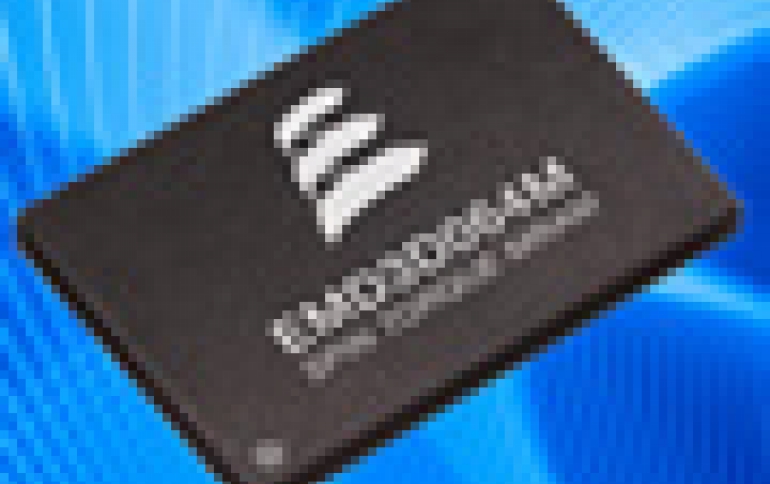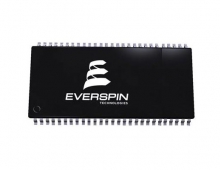
Everspin 64Mb DDR3 ST-MRAM Offers 500X Performance of Flash
Everspin Technologies leads the industry in commercializing the first Spin-Torque Magnetoresistive RAM (ST-MRAM), a new type of high performance and ultra-low latency memory, which offers an fast alternative to non-volatile DRAM sub systems.
ST-MRAM is a performance-optimized Storage Class Memory (SCM) that rovides non-volatility, high endurance and ultra-low latency. The 64Mb device is the first product in Everspin?s ST-MRAM roadmap that is planned to scale to gigabit density memories with faster speeds.
The new memory type has about 500 times the speed of NAND flash but the endurance of DRAM. In addition, a 1Gbit MRAM chip would use 400 milliwatts of power, compared to a 64Gbit NAND flash chip, which uses 80 milliwatts of power, according to Everspin.
"The properties of ST-MRAM are particularly appealing to the enterprise SSD market because of its ability to enhance and complement flash memory technology," said Joseph Unsworth, research vice president at Gartner. "The commercialization of this technology is an important industry milestone that should continue to drive SSD proliferation in data center and in-memory computing architectures."
The first semiconductor memory that combines the speed and endurance of DRAM with the non-volatility of Flash, ST-MRAM gives designers of high performance storage systems the ability to achieve ultra low latency, increase reliability with high cycling endurance and protect data in the event of power loss. One example of potential use is in the area of cloud storage?even as more users and content are added, faster and consistent data storage access is a necessity.
Everspin?s proprietary Spin-Torque technology uses a spin-polarized current for switching. Data is stored as a magnetic state versus an electronic charge, providing a non-volatile memory bit that does not suffer wear-out or data retention issues associated with Flash technology. The EMD3D064M 64Mb ST- MRAM is functionally compatible with the industry standard JEDEC specification for the DDR3 interface, which delivers up to 1600 million transfers per second per I/O, translating to memory bandwidth of up to 3.2 GBytes/second at nanosecond class latency. The product is offered in an industry standard WBGA package aligned with the DDR3 standard.
ST-MRAM chips are about 50 times more expensive than NAND flash, meaning it's not viable as a mass storage device. However, in terms of performance, ST-MRAM can produce 400,000 random write I/Os per second (IOPS) using 4K blocks compared to NAND flash with 800 random IOPS.
Everspin is manufacturing ST-MRAM on its 200mm production line in Chandler, Arizona and is collaborating with other companies to establish 300mm MRAM tools and additional fab capacity. Everspin is also working with design partners to ensure that the required tools and support are in place to drive the rapid adoption of ST-MRAM, including the necessary memory controllers, memory modules (DIMMs) and evaluation platforms.
Everspin is shipping working samples of the EMD3D064M 64Mb DDR3 ST- MRAM to select customers and will announce details on broad availability in 2013.
ST-MRAM pricing per GB is expected to scale from SRAM pricing levels to DRAM pricing levels over the next 5 years.
The new memory type has about 500 times the speed of NAND flash but the endurance of DRAM. In addition, a 1Gbit MRAM chip would use 400 milliwatts of power, compared to a 64Gbit NAND flash chip, which uses 80 milliwatts of power, according to Everspin.
"The properties of ST-MRAM are particularly appealing to the enterprise SSD market because of its ability to enhance and complement flash memory technology," said Joseph Unsworth, research vice president at Gartner. "The commercialization of this technology is an important industry milestone that should continue to drive SSD proliferation in data center and in-memory computing architectures."
The first semiconductor memory that combines the speed and endurance of DRAM with the non-volatility of Flash, ST-MRAM gives designers of high performance storage systems the ability to achieve ultra low latency, increase reliability with high cycling endurance and protect data in the event of power loss. One example of potential use is in the area of cloud storage?even as more users and content are added, faster and consistent data storage access is a necessity.
Everspin?s proprietary Spin-Torque technology uses a spin-polarized current for switching. Data is stored as a magnetic state versus an electronic charge, providing a non-volatile memory bit that does not suffer wear-out or data retention issues associated with Flash technology. The EMD3D064M 64Mb ST- MRAM is functionally compatible with the industry standard JEDEC specification for the DDR3 interface, which delivers up to 1600 million transfers per second per I/O, translating to memory bandwidth of up to 3.2 GBytes/second at nanosecond class latency. The product is offered in an industry standard WBGA package aligned with the DDR3 standard.
ST-MRAM chips are about 50 times more expensive than NAND flash, meaning it's not viable as a mass storage device. However, in terms of performance, ST-MRAM can produce 400,000 random write I/Os per second (IOPS) using 4K blocks compared to NAND flash with 800 random IOPS.
Everspin is manufacturing ST-MRAM on its 200mm production line in Chandler, Arizona and is collaborating with other companies to establish 300mm MRAM tools and additional fab capacity. Everspin is also working with design partners to ensure that the required tools and support are in place to drive the rapid adoption of ST-MRAM, including the necessary memory controllers, memory modules (DIMMs) and evaluation platforms.
Everspin is shipping working samples of the EMD3D064M 64Mb DDR3 ST- MRAM to select customers and will announce details on broad availability in 2013.
ST-MRAM pricing per GB is expected to scale from SRAM pricing levels to DRAM pricing levels over the next 5 years.





















